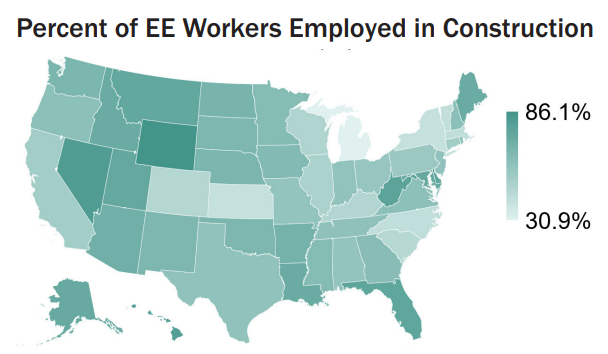

By Erin Cosgrove | Fri, July 28, 23
The U.S. Department of Energy (DOE) has released guidance for $150 million in formula funding for the State-Based Energy Efficiency Contractor Training Grants (Contractor Training Program). The Contractor Training Program provides funding to state energy offices to train, test, and certify energy efficiency and electrification contractors. The funding is not just for IRA programs, but also to help states grow other efficiency programs, such as the Weatherization Assistance Program, and state utility or third party-run energy efficiency programs.
Energy efficiency already represents the largest source of employment in the clean energy sector, with most employment happening on the local level in design, construction, operation, and maintenance jobs. Blue Green Energy Alliance and E4theFuture have estimated that there will be 49,000 full time jobs in energy efficiency from IRA investment, representing a big opportunity for the industry. This funding will be the first time most states will have the opportunity to invest in and lay the groundwork for a well-trained, equitable statewide energy efficiency workforce. In this blog, NEEP will define the energy efficiency workforce and outline how this funding can be used to grow the workforce.
What is an Energy Efficiency Workforce?
The energy efficiency workforce is comprised of numerous pathways and professions, including electricians, HVAC contractors, plumbers, energy auditors, Home Energy Rating Systems (HERS) Raters, and building performance contractors.
Growing the Workforce with Contractor Training Program Grants
States across the Northeast and Mid-Atlantic region have conducted workforce gap surveys and found that the highest demand jobs include electricians, construction workers, and HVAC technicians. Additionally, surveys have found that contractors and workers are often times interested in joining this field, but have trouble identifying educational resources and training opportunities.
States can use the Contractor Training Program to begin to address these gaps and lay the groundwork for lasting programs. Below NEEP has outlined some considerations for states in designing programs, and suggested key ways the region can work together to create lasting change.
Image Source: E2 and E4TheFuture Energy Efficiency Jobs in America
-
Create common trainings, certifications, and installation practices for heat pumps, heat pump water heaters, and building performance contractors across the region. Workforce often crosses state lines, so pursuing similar program offerings and certification requirements on a regional level can make it easier for businesses to work throughout the region. Additionally, common trainings and certifications can ensure proper installation and operation of products. States in the NEEP region have programs that can be used as examples and prototypes for new workforce training programs. In Vermont, a Weatherization Workforce Group created a statewide building science curriculum which resulted in a “certification that is broadly recognized, transparent, and portable.” For heat pumps, Vermont, New York, and Maine tie rebates to installation by a trained contractor. Further, through collective action, state energy offices could set the standards for workforce, equipment, and installation practices.
-
Creating a statewide workforce working group that leverages local and regional resources to monitor implementation. Meaningful stakeholder engagement can ensure programs serve the community and are cognizant of barriers to entry for disadvantaged communities, such as building trust in the community, educating residents about these opportunities, and other services that may be community specific (such as transportation and access to training facilities). Additionally, a stakeholder group that is informed and empowered to track implementation can ensure program implementers are held accountable to program goals and are regularly adapting programs to improve them and increase access. Maine’s Clean Energy Partnership Program (CEP), which advances clean energy, climate, economic development, and workforce goals, is a successful example in the Northeast.
-
Utilize online contractor-led certification programs to retrain current and introduce new workers. Resources that are widely available online allow people to explore concepts and receive training on their own time outside the rigid schedule of a class. NEEP is working with Building Performance Institute and Building Performance Association to launch a Total Building Performance Certificate. This online learning module, which covers a wide range of topics to prepare contractors and employees with the skills to think holistically about a home retrofit, will culminate with a certificate of knowledge. In addition to training, states can also provide trainees with clear steps for long-term growth and advancement in the field. The Green Buildings Career Map can be used as a starting point to design pathways.
-
Identify best practices to serve underserved communities and share lessons learned. To design programs that deliver benefits to underserved communities, states will need to consider ways to support trainees through wrap-around services and paid on-the-job training, engage with local communities through partnering with trusted groups, and utilize robust stakeholder feedback to design and implement the programs. Regional coordination and sharing of practices on equity initiatives can help states incorporate new policies and programs, as this can act as a peer learning exchange around innovative programs and lessons learned. States in the NEEP region can learn from successful programs, such as District of Columbia Sustainable Energy utility Energy Efficiency Workforce Development Program, and identify how to implement similar programs for their residents.
What’s Next?
From 2014 to 2019, the energy efficiency industry outpaced job growth in the economy at large, yet the industry must still grow. In 2022, NREL released a study indicating that, for states to reach their 2030 clean energy goals, energy efficiency industry in the NEEP region needs to grow by almost 400 percent. Now is the time for states to take innovative and industry-changing steps by establishing long-term, equitable workforce programs through coordinating and connecting community, state, and regional resources. Leveraging the Contractor Training Program with additional community, state, and regional resources can accelerate growth in the energy efficiency workforce and help states achieve their clean energy goals.

